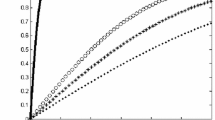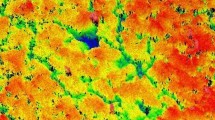Abstract
We consider a series of flat contact spots distributed over a half-space, for which the pull-off force is proportional to the square root of the total contact area over the elastic compliance. By using an electro-mechanical analogy to compute the compliance using the well-known Greenwood–Holm equation, we show how the pull-off decays for fractal patterns of contact spots with simple scaling laws, tending to zero in a fractal limit, as the contact area goes to zero. Moreover, a qualitative assessment is made for contact of fractal rough surfaces, and it is shown that pull-off in this case is dominated by the value of the contact area reached during the loading process, which depends on the applied load, suggesting pressure-sensitive adhesion.





Similar content being viewed by others
Notes
Notice that the 1D random surface may well enhance adhesion and hysteresis as per the Guduru effect. A fully 2D random rough surface may show a qualitatively different behaviour, but such simulations are not available to date.
References
Bartlett MD, Croll AB, King DR, Paret BM, Irschick DJ, Crosby AJ (2012) Looking beyond fibrillar features to scale gecko-like adhesion. Adv Mater 24(8):1078–1083
Johnson KL, Kendall K, Roberts AD (1971) Surface energy and the contact of elastic solids. Proc R Soc Lond A 324:1558
Fuller KNG, Tabor D (1975) The effect of surface roughness on the adhesion of elastic solids. Proc R Soc Lond A Math Phys Eng Sci 345(1642):327–342
Pastewka L, Robbins MO (2014) Contact between rough surfaces and a criterion for macroscopic adhesion. Proc Natl Acad Sci 111(9):3298–3303
Guduru PR (2007) Detachment of a rigid solid from an elastic wavy surface: theory. J Mech Phys Solids 55:473–488
Guduru PR, Bull C (2007) Detachment of a rigid solid from an elastic wavy surface: experiments. J Mech Phys Solids 55:473–488
Afferrante L, Ciavarella M, Demelio G (2015) Adhesive contact of the Weierstrass profile. Proc R Soc A 471(2182):20150248
Barber JR (2003) Bounds on the electrical resistance between contacting elastic rough bodies. Proc R Soc Lond A 459(2029):53–66
Holm R (1929) Siemens-Werken. Wiss Veroff 7(2):217–258
Greenwood JA (1966) Constriction resistance and the area of real contact. Br J Appl Phys 17:1621–1632
Manners W, Gholami B (2005) Constriction resistance between materials with fractal patterns of contact. In: IEE proceedings on science, measurement and technology, vol 152, no 4. IET, pp 161–168
Warren TL, Krajcinovic D (1996) Random Cantor set models for the elastic-perfectly plastic contact of rough surfaces. Wear 196(1–2):1–15
Yang F, Pitchumani R (2001) A fractal Cantor set based description of interlaminar contact evolution during thermoplastic composites processing. J Mater Sci 36:4661–4671
Abuzeid OM, Eberhard P (2007) Linear viscoelastic creep model for the contact of nominal flat surfaces based on fractal geometry: standard linear solid (SLS) material. J Tribol 129(3):461–466
Carbone G, Pierro E, Recchia G (2015) Loading-unloading hysteresis loop of randomly rough adhesive contacts. Phys Rev E 92(6):062404
Johnson KL (1995) The adhesion of two elastic bodies with slightly wavy surfaces. Int J Solids Struct 32(3):423–430
Ciavarella M, Demelio G, Barber JR, Jang YH (2000) Linear elastic contact of the Weierstrass profile. Proc R Soc Lond A Math Phys Eng Sci 456(1994):387–405
Ciavarella M, Murolo C, Demelio G (2006) On the elastic contact of rough surfaces: numerical experiments and comparisons with recent theories. Wear 261(10):1102–1113
Persson BNJ (2014) On the fractal dimension of rough surfaces. Tribol Lett 54:99–106. doi:10.1007/s11249-014-0313-4
Ciavarella M (2015) Adhesive rough contacts near complete contact. Int J Mech Sci 104:104–111
Author information
Authors and Affiliations
Corresponding author
Ethics declarations
Conflict of interest
The authors declare that they have no conflict of interest.
Rights and permissions
About this article
Cite this article
Papangelo, A., Afferrante, L. & Ciavarella, M. A note on the pull-off force for a pattern of contacts distributed over a halfspace. Meccanica 52, 2865–2871 (2017). https://doi.org/10.1007/s11012-017-0650-0
Received:
Accepted:
Published:
Issue Date:
DOI: https://doi.org/10.1007/s11012-017-0650-0




